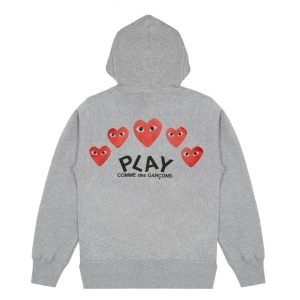Fashion has always been about beauty, elegance, and the desire to follow trends. But not every designer has chosen to follow these established paths. Some have questioned the system, daring to step outside tradition, and in doing so, they have changed fashion forever. comme des garçons One of the most influential names in this regard is Comme des Garçons, the groundbreaking brand created by Rei Kawakubo. More than just a label, Comme des Garçons represents a philosophy, a way of thinking that has transformed how we view clothing, style, and even fashion itself. By rejecting conventions and redefining beauty, the brand has not only created clothing but sparked cultural conversations about identity, rebellion, and freedom.
The Birth of Comme des Garçons
Comme des Garçons, which translates to “like boys” in French, was founded in Tokyo in 1969 by Rei Kawakubo. From its very beginning, the label positioned itself as something unusual, neither fitting the mold of Japanese tradition nor following Western norms. Kawakubo herself came from a background in fine arts rather than traditional fashion design, and this shaped her perspective. She approached clothing not as garments to decorate the body but as a medium for expression and storytelling.
In the early days, Comme des Garçons was a small independent venture, but by the 1970s, it had become a driving force in Japan’s avant-garde movement. When Kawakubo presented her collections in Paris during the 1980s, the fashion world took notice. Instead of colorful, glamorous silhouettes, she introduced distressed fabrics, asymmetry, and dark tones. The press dubbed her designs “anti-fashion,” yet her vision resonated deeply with those who were tired of fashion’s obsession with perfection.
Challenging Conventional Beauty
One of the most significant ways Comme des Garçons has redefined the rules of fashion is by challenging conventional ideas of beauty. Kawakubo’s collections often featured deconstruction, holes, unfinished hems, and shapes that concealed rather than revealed the body. This stood in stark contrast to the glamorous ideals promoted by fashion houses in Paris, Milan, and New York.
Her work rejected the notion that clothing must flatter the body in traditional ways. Instead, she created pieces that distorted proportions, reimagined silhouettes, and used imperfection as an aesthetic tool. The 1997 collection “Body Meets Dress, Dress Meets Body,” often referred to as the “lumps and bumps” collection, is a striking example. Kawakubo added padded bulges to dresses, challenging the narrow ideals of body shape and asking audiences to reconsider what beauty truly meant.
A Philosophy Beyond Clothing
Comme des Garçons is not just about garments but about ideas. Kawakubo has often described her process as creating “the in-between,” a space where contradictions coexist. The clothing is less about making people look fashionable and more about provoking thought. Her designs force audiences to confront questions about gender, identity, and culture.
This philosophical approach has set the brand apart from commercial labels. While most fashion houses balance creativity with the demands of mass appeal, Comme des Garçons has always prioritized artistic integrity. Kawakubo herself has famously stated that she designs for herself, not to satisfy others. By remaining true to this vision, the label has cultivated a loyal following that values creativity, originality, and authenticity above trends.
The Role of Collaboration and Expansion
While Comme des Garçons has maintained its avant-garde identity, it has also expanded into other realms of fashion. The launch of sub-labels like Comme des Garçons Homme, Comme des Garçons Play, and Comme des Garçons Noir has allowed the brand to explore different aesthetics and markets. Perhaps one of the most significant steps was the opening of Dover Street Market in London in 2004. This retail space, part concept store and part gallery, redefined how people experience shopping. It became a cultural hub where art, fashion, and design converged.
Comme des Garçons has also engaged in collaborations with global brands, including Nike, Converse, and Supreme. These collaborations allowed Kawakubo’s unconventional vision to reach wider audiences without diluting the brand’s identity. The iconic heart logo with playful eyes, created for Comme des Garçons Play by artist Filip Pagowski, is one of the most recognizable symbols in modern fashion, bridging the gap between high fashion and streetwear.
The Cultural Impact of Comme des Garçons
The influence of Comme des Garçons extends far beyond the runway. It has become a symbol of resistance against conformity, encouraging people to embrace individuality. Kawakubo’s refusal to follow traditional gender codes in her designs has inspired conversations about gender-neutral fashion long before it became mainstream. By prioritizing creativity over commercial success, she showed that fashion could be a powerful form of cultural critique.
Artists, musicians, and creative thinkers have long gravitated toward the brand because of its rebellious spirit. From David Bowie to Kanye West, Comme des Garçons has been embraced by those who see clothing as more than fabric but as a form of personal statement. The brand’s work has even been featured in major museum exhibitions, including the Metropolitan Museum of Art’s 2017 exhibition “Rei Kawakubo/Comme des Garçons: Art of the In-Between,” which cemented its status as both fashion and art.
Redefining the Future of Fashion
Comme des Garçons continues to influence fashion’s future by rejecting predictability. Each collection is a surprise, often leaving audiences divided but always sparking conversation. Kawakubo’s role has also shifted, with younger designers under her mentorship carrying forward the label’s spirit. At the same time, Comme des Garçons remains firmly rooted in the avant-garde, ensuring it never becomes complacent or formulaic.
In a fashion industry that often prioritizes consumerism and fleeting trends, Comme des Garçons stands as a reminder that true innovation comes from courage and creativity. Kawakubo’s refusal to conform has not only redefined the rules of fashion but has also broadened our understanding of what clothing can represent.
Conclusion
Comme des Garçons is more than a brand; it is a philosophy of disruption and creativity. By questioning beauty, rejecting tradition, and exploring the “in-between,” Rei Kawakubo has transformed fashion into an intellectual and cultural experience. From the early days of shocking Paris with all-black collections to today’s global collaborations and exhibitions, Comme des Garçons has consistently defied expectations.
To redefine the rules of fashion requires boldness, vision, and the willingness to stand apart. Comme des Garçons embodies all of these qualities. Its story proves that fashion does not have to be about following rules—it can be about rewriting them entirely. Through its journey, the brand continues to remind us that clothing is not just about how we look, but about how we think, feel, and express who we are.


